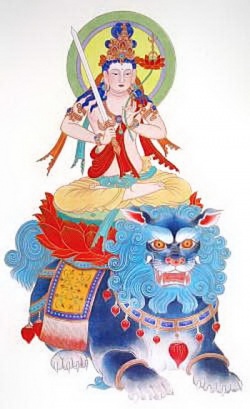Difference between revisions of "Manjushri bodhisattva"
m (Text replacement - "Buddhist art" to "Buddhist art") |
m (1 revision: Robo 2.48 15 septmeber replacetext) |
(No difference)
| |
Revision as of 19:52, 14 September 2013
Manjushri
[文殊師利菩薩・文殊菩薩] (Skt; Jpn Monjushiri-bosatsu or Monju-bosatsu)
A bodhisattva who appears in the sutras as the leader of the bodhisattvas and is regarded as symbolic of the perfection of wisdom. Sutras depict him as one of the two bodhisattvas who attend Shakyamuni Buddha, the other being Samantabhadra, or Universal Worthy. Manjushriis generally shown in Buddhist art riding a lion at the Buddha's left, and represents the virtues of wisdom and enlightenment. Shakyamuni's right-hand attendant, Bodhisattva Universal Worthy, shown riding a white elephant, represents the virtues of truth and practice. According to the Flower Garland Sutra, Manjushrilives on Mount Clear and Cool in the east, which came to be identified with Mount Wu-t'ai in China. Belief in Manjushriflourished in China from the Eastern Chin dynasty (317-420) and in Japan from the Heian period (794-1185).
